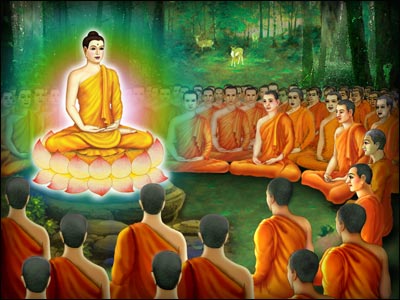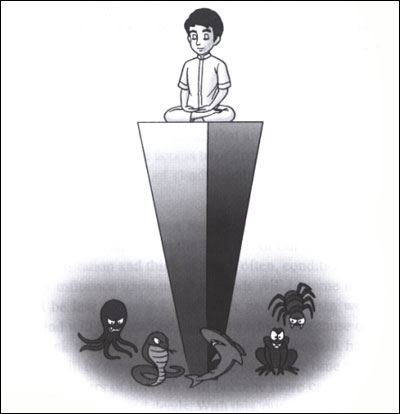The Noble Truth of the Cessation of Suffering # 2Thus the Lord Buddha taught that if we can overcome our greedyHow can Craving be extinguished?Thus the Lord Buddha taught that if we can overcome our greedy attachments to the things we love in the world, craving can be overcome too.Thus we can see that the target for our practice is to uproot the state of attachment if we can succeed in uprooting attachment, we can uproot craving too. Craving is engrained at all levels of the sensory processing of our mind. There are a total of ten stages in the sensory process and six sensory channels giving a total of sixty places (a group of mental phenomena known as the ‘Objects of Sensual Delight and Pleasure’ [piyarupa satarupa](see Table II overleaf) where craving can lurk!TABLE : THE OBJECTS OF SENSUAL DELIGHT AND PLEASUREOur sense organs [ajjhattikayatana] are implicated in the attachment we have to sensual pleasures. If we want to extinguish the craving arising because of attachment to visual temptations, then we have to extinguish them at the eye. In the same way, if you want to overcome the attachment to pleasures coming via the other senses (sounds, perfumes, tastes, touches and inner experience that falls short of enlightenment) then you have to overcome them at their respective sense organs (ears, nose, tongue, tongue, body and mind).the sensual objects [bahirayatana] are implicated in the attachment we have to sensual pleasures.Moreover, the sensual objects [bahirayatana] are implicated in the attachment we have to sensual pleasures. As attachment to things has roots in the objects themselves, we have to extinguish them also, at the object itself. If we are attached to certain pleasurable sights then we have to extin guish attachment at that visual object too. In the same way, if you want to overcome the attachment to pleasures coming via the other senses (sounds, perfumes, tastes, touches and inner experience that falls short of enlightenment ) then we have to overcome them at their respective objects (sounds, perfumes, tastes, touches and inner experience that falls short of enlightenment).Moreover, our consciousness [uinnana] is implicated in our attachment to sense pleasure. By consciouseness, we mean the awareness of the objects arising in the senses. Each of the senses has its own channel of consciousness therefore there are a further six areas in which the practitioner needs to extinguish craving –visual consciousness [cakkhu-vinnana], auditory consciousness [cakkhu-vinnana], auditory conscipusness [sota-vinnana], olfactory consciousness [Ghana-vinnana], gustatory consciousness [jivha-vinnana] tactile consciousness [kaya-uinnana] and mental consciousness [mano vinnana].Moreover, the contact [samphassa] between the three previous factors –senses, sense objects and sense-consciousness-is implicated in the attachment we have to sensual pleasures. Again, each of the six senses has its own channel of sense-contact therefore there are a further six areas in which the practitioner needs to extinguish craving-visual contact [cakkhu-samphassa], auditory contact [sota-samphassa], auditory contact [sota-samphassa], olfactory contact [ghanasamphassa], gustatory contact [jivha-samphassa] tactile contact [kaya-samphassa] and mental contact [manosamphassa].the pleasurable feeling [vedana] arising from the aforementioned contact is implicated in the attachment we have to sensual pleasures.Moreover, the pleasurable feeling [vedana] arising from the aforementioned contact is implicated in the attachment we have to sensual pleasures. Again, each of the six senses has its own channel of sense-feeling therefore there are a further six areas in which the practitioner needs to extinguidh craving visual feeling [cakkhu-uedana], auditory feeling [sota-vedana], olfactory feeling [Ghana-vedana], gustatory feeling [jivha]vedana], tactile feeling [kaya-vedana] and mental feeling [mano-vedana].Moreover, the perception (sensory registration) [sanna] arising from the aforementioned feeling is implicated in the attachment we have to sensual pleasures. Again, each of the six senses has its own channel of sense-perception therefore there are a further six areas in which the practitioner needs to extinguish craving –visual perception [rupa-sanna], auditory perception [sadda-sanna], olfactory perception [gandha-sanna], gustatory perception [rasa-sanna], tactile perception [photthabba-sanna] and mental perception [dhamma-sanna].Moreover, the volition concerning our sensual objects, or our choice of sensual objects or our will directed at sensual our choice of sensual objects or our will directed at sensual objects [sancetana] arising from the aforementioned sensory registration is implicated in the attachment we have to sensual pleasures. Again, each of the six senses has its own channel of sense-volition therefore there are a further six areas in which the practitioner needs to extinguish craving volitions concerning visual images [rupa-sancetana], volitions concerning sounds [gandha-sancetana], volitions is implicated in the attachment we have to sensual pleasures. Again, each of the six senses has its own channel of sensecraving therefore there are a further six areas in which the practitioner needs to extinguish craving –craving concerning visual images [rupa-tanha], craving concerning sounds [sadda-tanha], craving concerning perfumes [gandhatanha], craving concerning tastes [rasa-tanha], craving concerning bodily sensations [photthabba-tanha] and craving concerning of the mental objects [dhamma-tanha].is implicated in the attachment we have to sensual pleasures.Moreover, the thought-conception [uitaka] concerning our sensual objects arising from the aforementioned sensory craving is implicated in the attachment we have to sensual pleasures. Again, each of the six senses has its own channel of sensory thought –conception therefore there are a further six areas in which the practitioner needs to extinguish craving thought conception concerning visual images [rupavitaka], thought –conception concerning perfumes [gandha vitaka], thought –conception concerning tastes [gandhavitaka], thought – conception concerning tastes [rasa-vitaka], thought –conception concerning bodily sensations [photthabba-vitaka] and thought – conception concerning of the mental objects [dhamma-uitaka].Moreover, the discursive thought [vicara] concerning our sensual objects arising from the aforementioned sensory thought-conception is implicated in the attachment we have to sensual pleasures. Again, each of the six senses has its own channel of sensory discursive thought therefore there are a further six areas in which the practitioner needs to extinguish craving-discursive thought concerning visual images [rupa-vicara], discursive thought concerning sounds [gandha-vicara], discursive thought concerning tastes [rasa-vicara], discursive thought concerning tastes [rasa-vicara], discursive thought concerning bodily objects [photthabba-vicara] and discursive thought concerning of the mental objects [dhamma-vicara].Thus, the emotions of pleasurable attachment concerning the sensory process of all six sense-channels need to be over-come. Only when they have been overcome at all levels and in all sense-channels can the extinguishing of suffering be achieved.
The Noble Truth of the Cessation of Suffering # 2
Thus the Lord Buddha taught that if we can overcome our greedy attachments to the things we love in the world, craving can be overcome too
6013 ครั้ง
ปิดการแสดงความคิดเห็น



![the sensual objects [bahirayatana] are implicated in the attachment we have to sensual pleasures. the sensual objects [bahirayatana] are implicated in the attachment we have to sensual pleasures.](https://images.dmc.tv/www/images/meditationNAW/az0-2.jpg)
![the pleasurable feeling [vedana] arising from the aforementioned contact is implicated in the attachment we have to sensual pleasures. the pleasurable feeling [vedana] arising from the aforementioned contact is implicated in the attachment we have to sensual pleasures.](https://images.dmc.tv/www/images/meditationNAW/az0-5.jpg)





![The Noble Truth of Suffering : 6. Lamentation [parideva dukkha]](https://images.dmc.tv/article/images/cover/1594748934.jpg)




